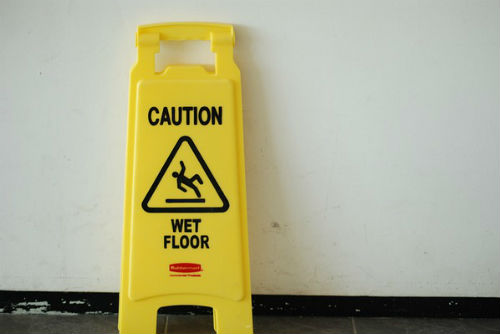Maybe it seems like splitting hairs, but there are big differences between a SLIP and fall and a TRIP and fall, and the difference can mean a lot when it comes to the legal side of things.
Most people have probably heard the term “slip and fall”. It may seem confusing to have a separate category for tripping accidents. Let’s talk about the difference between them.
What exactly is a Slip and Fall?
Let’s imagine for a moment that you’re perusing the shelves at your local grocery store. On the floor of an isle is a broken jar of sauce. You don’t notice the mess, and while scanning the isle for your favorite spaghetti sauce and you step on the broken jar. This causes your leg to hyperextend, or even worse you end up on your back on the floor. You call an ambulance and curse the grocery store on the way out. This is an example of a slip and fall.
A slip is when you slip on substance that makes a floor unsafe. Another common slipping hazard is ice. Ice can form very quickly and be difficult to spot on dark surfaces such as blacktop. This can occur if a landlord, business or homeowner failed to properly prevent slip and falls on the ice.
What is a Trip and Fall?
A trip and fall is a little different. Let’s go back to the grocery store scenario. Let’s say you made it past the broken jar isle and did not slip and fall. Now you venture over to the next isle where another spill has happened. This time, an employee has already cleaned the mess up; however, they left the mop on the ground. Once again, you don’t notice the mop. You go down hard on your hands and knees. This is a trip and fall.
As the little story suggests, a trip and fall happens when an object is sticking out of its normal place or a surface is uneven. Most times, you catch your foot on it which causes you to fall abruptly. A trip and fall could also be an uneven sidewalk in Columbus. Unfortunately, those are all too common.
Legal Issues
These differences may seem subtle, but there is a big difference legally. When it comes to making your case in front of the jury, you have to make sure that you know the difference.
A slip and fall usually results in severe injuries. The slip tends to propel the body backwards. Depending on the velocity of your movements, you could seriously injure your head, neck, or spine.
When you trip, the body typically falls forward. You use your hands and knees to brace your fall. We learned this when we were children. Therefore, a trip and fall tends to cause injuries in the hands, knees, face, or wrists depending on how you attempted to catch yourself when you fell.
For both of these instances, you want to make sure that you keep all medical records. Medical records are important if you decide to sue the person, people or entity responsible for your injuries. Due to the nature of a slip and fall, you want to remember as much details as you can. The more information you have, the easier it will be to prove negligence.
If anyone approached you after either of these falls, make sure to remember a name or at least a description of them. If the owners or managers responsible for the store sold you promises, it may be relevant to your case.
Deciding to Sue.
If you make the decision to bring a lawsuit for your medical expenses and pain and suffering, you have two years to bring your lawsuit. There is a 2 year statute of limitations that begins at the time of injury or time of discovery of the injury.
You deserve to be made whole for your slip and fall or trip and fall, and you deserve a dedicated team behind you. Call Columbus Injury Attorney Tom Marchese at 614-486-3249.




